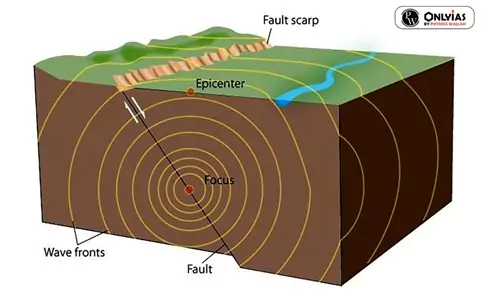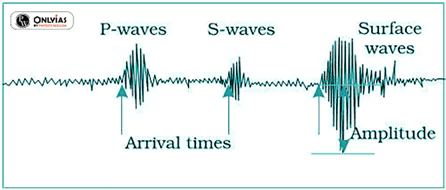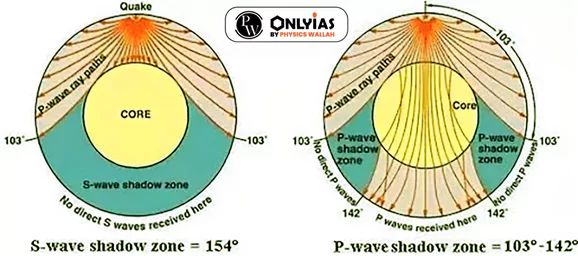Understanding Earthquakes, from Small Shakes to Big Disasters – Result of Seismic waves
Earthquakes are natural disasters that result from the sudden release of energy in the Earth’s crust, leading to seismic waves that shake the ground. These ground-shaking events are often triggered by the movement of tectonic plates beneath the Earth’s surface. Earthquakes can vary in magnitude and impact, from minor tremors that go unnoticed to catastrophic quakes that cause widespread destruction and loss of life.
Earthquake: Shaking of the Earth and the Science of Seismic Waves
Earthquakes are natural events characterised by the shaking of the Earth’s surface.
- These phenomena are caused by the sudden release of energy, giving rise to seismic waves that radiate in all directions.
- The Mechanism Behind Earthquakes: Earthquakes occur due to the release of energy along geological features known as faults, which are sharp breaks in the Earth’s crust.
- Rocks along a fault tend to move in opposite directions, but friction keeps them locked in place.

-
- When the force attempting to push these rocks apart overcomes the friction, they suddenly slide past each other.
- This abrupt movement results in the release of energy, which generates seismic waves that propagate in various directions.
Exploring the Earthquake Terminology: Navigating the Focus and Epicentre – Key Terms in Seismic Science
- Focus (Hypocentre): The point within the Earth where the energy release occurs is known as the focus of an earthquake.
- Epicentre: This is the point on the Earth’s surface closest to the focus, and it is the first location to experience the seismic waves.
- The epicentre is directly above the focus and serves as a crucial reference point for assessing earthquake impact.
Exploring Earth’s Seismic waves: Understanding the Diverse Causes of Earthquakes, from Tectonic Plates to Human Activities
Earthquakes result from the movement of the Earth’s tectonic plates and other geological processes.
- Tectonic Plate Movements: Most earthquakes are caused by the interactions of tectonic plates.
- These massive sections of the Earth’s crust are constantly shifting and grinding against each other.
- When plates move apart (divergent boundaries), collide (convergent boundaries), or slide past each other (transform boundaries), the built-up stress is suddenly released, generating seismic waves.
- Example: The 2020 Izmir earthquake in Turkey was a result of the collision between the African and Eurasian plates.
- Subduction Zones: Subduction zones occur at convergent plate boundaries where one tectonic plate is forced beneath another.
- This process can create intense pressure and friction, leading to earthquakes.
- Example: The 2011 Tōhoku earthquake and tsunami in Japan was caused by the subduction of the Pacific Plate beneath the North American Plate.
- Volcanic Activity: Earthquakes often accompany volcanic eruptions.
- The movement of magma and the release of gases beneath the Earth’s surface can trigger seismic events.
- Example: The Ring of Fire around the Pacific Ocean experiences many earthquakes related to volcanic activity.
- Human Activities:Human activities, such as mining, reservoir-induced seismicity (due to the filling of large dams), and hydraulic fracturing (fracking), can induce earthquakes.
- These are known as induced earthquakes.
- Example: The 1967 Koynanagar earthquake in India was linked to the filling of the Koyna Dam reservoir.
- Faults: Faults are fractures in the Earth’s crust where rocks on either side have moved relative to each other.
- Sudden movements along these faults release energy, causing earthquakes.
- Example: The 2019 Ridgecrest earthquakes in California were due to the movement along the Eastern California Shear Zone.
Earthquake Waves: Navigating the Depths of Seismic Motion and the Crucial Role of Seismographs
- Earthquake Location: All natural earthquakes originate within the Earth’s lithosphere, a region extending up to 200 kilometres from the planet’s surface.
- Seismograph’s Role: Seismographs, specialised instruments, capture the waves reaching the Earth’s surface.
- Types of Earthquake Waves: Earthquake waves come in two primary categories: body waves and surface waves.

- Body Waves: Body waves are generated at the earthquake’s focus (point of origin) and radiate in all directions, traversing the Earth’s interior.
- These waves interact with surface rocks, giving rise to a secondary set of waves known as surface waves.
- Wave velocity varies depending on the materials they traverse, with denser materials leading to higher velocities.
- The direction of waves can change as they reflect or refract when encountering substances of differing densities.
- P-Waves (Primary Waves): P-waves, or primary waves, travel the fastest and are the first to reach the surface.
- Similar to sound waves, P-waves can traverse gaseous, liquid, and solid materials.
- S-Waves (Secondary Waves): S-waves, or secondary waves, reach the surface with some delay.
- They can exclusively propagate through solid materials, a characteristic that has significantly contributed to our understanding of the Earth’s interior.
- Wave Behavior: Reflection and refraction influence wave direction.
- Reflection causes waves to bounce back, while refraction leads to changes in direction.
- Seismographs record the variations in wave direction, aiding in the interpretation of earthquake data.
- Surface Waves: Surface waves, as the final arrivals on seismographs, are more destructive.
- They displace rocks, often causing structural collapses and severe damage.
Propagation of Earthquake Waves: Vibration and Material Interaction
Earthquake waves exhibit different modes of travel, each resulting in distinct types of vibrations within the rocks they traverse. Understanding these characteristics is essential for comprehending the impact of seismic waves.
- P-Waves (Primary Waves): P-waves move parallel to the direction of wave propagation.
- They exert pressure on the material in the direction of their movement, creating density differences in the material.
- This leads to stretching and squeezing of the material.
- S-Waves (Secondary Waves): S-waves vibrate perpendicular to the direction of wave propagation in a vertical plane.
- As a result, they generate troughs and crests in the material they pass through.
- Surface Waves: Surface waves are considered the most destructive.
- They create complex patterns of ground motion, causing significant surface displacement and structural damage.
Each type of earthquake wave interacts with the Earth’s materials in a unique way, resulting in a diverse range of ground motions and potential damage. Surface waves, in particular, are known for their destructive impact and are of particular concern during seismic events.
Decoding Earth’s Silent Zones: Revealing the Mysteries of Seismic Shadow Zones in Earthquake Waves
- Recorded Earthquake Waves: Earthquake waves are recorded by seismographs located at various distances from the epicentre.
- However, there are specific regions where seismic waves are not detected. These areas are termed “shadow zones.”

- Different Shadow Zones: Each earthquake has its unique shadow zone, as revealed through the study of seismic events.
- Shadow Zones for P and S-Waves: For any given earthquake, seismographs within a range of 105° from the epicentre record both P and S-waves.
- Beyond 145° from the epicentre, seismographs only detect P-waves, while S-waves go unreported.
- Consequently, a region between 105° and 145° from the epicentre is identified as the shadow zone for both wave types.
- Comparing Shadow Zones: The shadow zone for S-waves is not only larger in extent but also covers slightly more than 40% of the Earth’s surface.
- In contrast, the shadow zone for P-waves appears as a band encircling the Earth between 105° and 145° away from the epicentre.
- Locating the Epicentre: To determine the shadow zone for a specific earthquake, knowledge of the epicentre’s location is essential.
Understanding the existence and characteristics of shadow zones is fundamental to the study of earthquake waves and their propagation, allowing scientists to better analyse and interpret seismic data.































